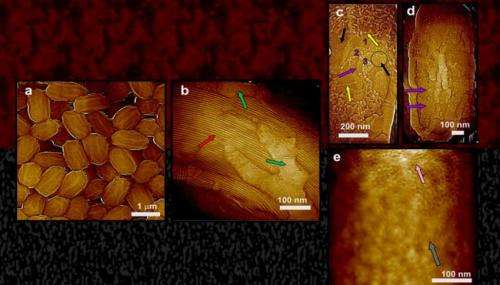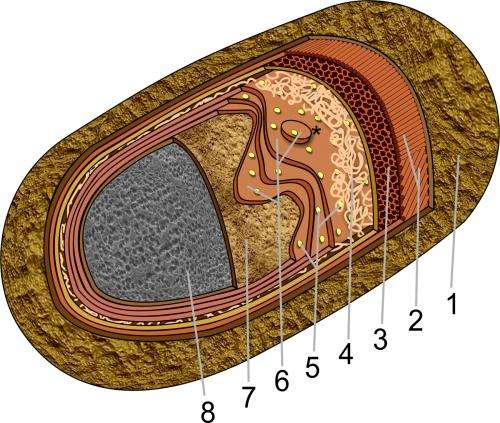Identifying the many layers of a bug's design

(Phys.org) —Lawrence Livermore researchers have discovered additional "coats," or layers, of a bacterium spore found in the human gut that may give clues to how this organism develops, spreads and survives in extreme conditions.
The team dove into the spore coats of the bacterium Bacillus subtilis, which also is known as hay bacillus or grass bacillus. Scientists found that in addition to the four known layers of the organism, it also contains a fibrous layer and a layer of "nanodot" particles, and these layers are dependent on specific coat proteins in order to assemble. The research allowed the team to form a more accurate model of the coat structure.
B. subtilis is a protein-rich, rod-shaped bacterium and has the ability to form spores that have a tough, protective coat, which allows the organism to tolerate extreme environmental conditions. Although this species is commonly found in soil, it also may be a normal gut bacterium found in humans. A 2009 study compared the density of spores found in soil to that found in humans. The number of spores in the human gut is too high to be attributed solely to consumption through food contamination. Soil serves as a reservoir, suggesting B. subtilis inhabits the gut and should be considered a normal gut bacterium.
Spores of Bacillus species are metabolically dormant and resistant to a large variety of environmental stress factors. While multiple factors contribute to spore resistance, one feature is the multilayer spore coat that provides protection against many toxic chemicals, as well as digestion by lytic enzymes or being eaten or killed by several types of predatory animals, plants and fungi.
Spore coat structure and assembly have been studied in B. subtilis, and about 70 spore specific proteins have been found in the spore coats.
"The spore coats of this bacterium are important because of their role in resistance and also because the proteins found in the coats play a significant role in spore germination," said Alexander Malkin, an LLNL biologist and lead author of the study in the Sept. 26 issue of the journal, PLOS ONE.
B. subtilis is only known to cause disease in severely immunocompromised patients, however, it can be used as a probiotic in healthy individuals.

For the study, the team used high-resolution atomic force microscopy to analyze the surface structure of natural spores as well as spores of a variety of mutant strains with defects in coat assembly to reveal the surface morphology of various layers of the spore coat. The results provided high-resolution visualization of the various spore coat structures (Figure 1) as well as several coat layers that had never been found
"This information has allowed us to formulate a model for coat structure (Figure 2) and provided further insight into the assembly of the spore coat, leading us to a better understanding of just how this bacterium ticks," Malkin said.
More information: Plomp M, Carroll AM, Setlow P, Malkin AJ (2014) "Architecture and Assembly of the Bacillus subtilis Spore Coat." PLoS ONE 9(9): e108560. DOI: 10.1371/journal.pone.0108560
"In vitro high-resolution structural dynamics of single germinating bacterial spores" Marco Plomp, et al. Proc Natl Acad Sci U S A. Jun 5, 2007; 104(23): 9644–9649. May 29, 2007. doi: 10.1073/pnas.0610626104
Journal information: PLoS ONE , Proceedings of the National Academy of Sciences
Provided by Lawrence Livermore National Laboratory















